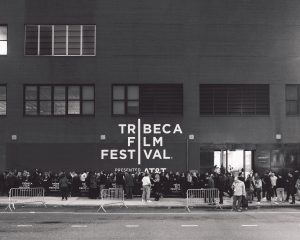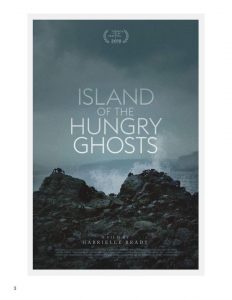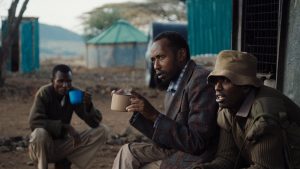This is cross-posted from the International Documentary Association newsletter.
What do you see at a film festival? At Tribeca Film Festival, that would be television programs, online episodes, online video, installations that incorporate virtual reality, 360 video and games. And films—especially the documentary films.
 The documentary lineup at #Tribeca2018 was rich in handsome, well-produced options and issue films were everywhere. On the environment, you could go for uplift/inspiring, Neil Gelinas’ Into the Okavango, which features a National Geographic expedition into the extraordinary Okavango Delta to catalog its native species, and The Serengeti Rules, which with spectacular imagery argues the importance of keystone species. On the terrifying end was Danfung Dennis and Eric Strauss’ This Is Climate Change, a set of short 360 videos putting viewers into the deforested Amazon, drought-ridden Somalia and wildfire-ravaged California—soon free on any VR headset via the Within app.
The documentary lineup at #Tribeca2018 was rich in handsome, well-produced options and issue films were everywhere. On the environment, you could go for uplift/inspiring, Neil Gelinas’ Into the Okavango, which features a National Geographic expedition into the extraordinary Okavango Delta to catalog its native species, and The Serengeti Rules, which with spectacular imagery argues the importance of keystone species. On the terrifying end was Danfung Dennis and Eric Strauss’ This Is Climate Change, a set of short 360 videos putting viewers into the deforested Amazon, drought-ridden Somalia and wildfire-ravaged California—soon free on any VR headset via the Within app.
State violence was spotlighted in several films, including the overlong but properly enraging Say Her Name: The Life and Death of Sandra Bland, soon on HBO. The consequences of racism infused Charm City (an IDA Enterprise Documentary Fund grantee), Marilyn Ness’ cinéma vérité closeup look at Baltimore violence from the perspective of a cop, a kid and a councilman; Laura Brownson’s The Rachel Divide, about Rachel Dolezal as a social refractor for racial attitudes (soon on Netflix); and 1,000 Cut Journey, a chance to experience daily discrimination in virtual reality. Online harassment, gender violence and prison culture were among other hot topics worthy of fullscreen attention.
There’s a special magic for me, though, in documentaries that help us understand not only what the issue is, but how it is, that help us to see how the things we know are wrong happen anyway, to grasp how people live in systems built by people, systems that then condition what people can do. In the end, there’s a meta-story. Of those, one standout was Gabrielle Brady’s Island of the Hungry Ghosts. This is a film that lingers with you long after it’s gone, bringing an enduring sense of loss, absence and regret. An Australian government therapist meets with her patients, all refugees on Australia’s Christmas Island off Indonesia. They are victims fleeing persecution, but are now in an open-air prison. The government keeps changing the rules, transferring her patients without warning, limiting the help she can provide them. That prison is on an island haunted, some Chinese think, by ancestors who came here as semi-enslaved labor and died without proper burial rites. The millions of island crabs that spawn in the ocean must navigate roads, ditches and people as they try to migrate from island to the water. The therapist, her subjects, the ghosts, the crabs—they are all caught in a story that is resolveable, but not by them. The meta-story is about what

Island of the Hungry Ghosts promotional poster.
the conditions of endless stricture do to those whose lives it is deforming. Citing the film’s “extraordinary mastery of the full symphonic range of cinematic tools,” the jury honored Island of the Hungry Ghosts with the Best Documentary Feature award.
Roll Red Roll, by Nancy Schwartzman (who, conflict alert, happens to be a second cousin by marriage), is another example. Taking the infamous Steubenville, Ohio story—high school footballers, drunk teen girl, group rape—she explores the present and past of casual misogyny. The story goes far beyond the headlines, and skips the finger-pointing. It asks, not cynically but with thoughtful curiosity, Why did kids think it was OK to publish sniggering, triumphant posts about the event on social media? It asks, Why was this kind of behavior not news, and not shocking to an older generation? The two questions are intertwined, and they involve institutions and relationships at all levels of this small town. The access Schwartzman got is extraordinary, and it shows in the frank, revealing conversations she captures. There are no easy answers for the culture that dehumanizes both this story’s men and women, but the film, an IDA Pare Lorentz Doc Fund grantee, asks the right questions.
Assia Boundaoui also gets down to the most interesting problem in her The Feeling of Being Watched, an IDA Enterprise Documentary Fund grantee. A seasoned journalist, she returns to her tight-knit Muslim community to investigate perennial rumors of FBI surveillance since 1995. The frontline questions are: Is this community paranoia? Is FBI surveillance real? The ultimate question, as the evidence of surveillance mounts, is: What does it do to people to have their own government gaslight them? She charts the erosion of faith in government, the self-blame, the vain attempts to protectively demonstrate patriotism, the sweltering anger. And she does so in interactions with “aunties” and “uncles” in her community, people who day after day stare frustrated at a car semi-permanently installed down the block. We could all pay attention to this corrosive phenomenon, as we all increasingly have that feeling of being watched. To drive home the point, during the festival the creative team screened a montage of FBI documents released through FOIA with images from the community on an NSA building in lower Manhattan whose function had been secret.

United Skates film still.
United Skates, by Dyana Winkler and Tina Brown, ought to succeed as a sports film alone. Come for the competitive roller-skating moves, definable by region (yes!). It’s not just a recreation, it’s a sport and an art form. But stay for the complexities of modern racism. The film charts the way the roller rink was a historic gathering place for African-Americans, who used their de facto segregated “Adult Night” to show off amazing new roller-enhanced choreography and celebrate each other. Under seige from developers, who find all those local African-Americans en masse (even with their roller skates in tow) alarming, skaters rally at nationwide annual events—which police find even more threatening. Working-class LA mom Phelicia is trying to find a place her teen boy can let off steam. Professional Reggie in North Carolina is trying to find a place he and his wife can relax into. The Crips and Bloods gangs in LA actually used skating rinks as demilitarized zones. United Skates, which picked up the Audience Award for Best Documentary, is another film with intimate access to people telling stories about little things—the weekly date at the skating rink—that end up being big, ugly, political, protesting-level, city-council-level, hollering things because of racism.
Two true-crime films bring you far past the tick-tock of events. For House Two, Michael Epstein followed the defense team after the murders of Iraqi civilians, including most of one family, by Marines. (He temporarily joined the defense team, which only after the trial released his footage back to him.) Viewers watch the military’s case against the platoon leader unravel, while the most likely suspects get immunity. The trial drags on for seven years. How shall we understand the ending, in which it becomes clear that General James Mattis, now Secretary of Defense, initiated the events that targeted the wrong man? One of Epstein’s hopes is that Mattis will see it, “and ask himself, ‘What happened here?’” He also thinks there are larger questions that the case poses: “The larger indictment is all of us. Where were we? It was plain to see and we didn’t care, we got bored with the war and moved along.” Because of the elegance and care of the storytelling—no gotcha moments, no cheap sentiment, no slighting of hard questions about soldiering in the terror and confusion of battle—Epstein lets us ask those bigger questions. Similarly, PJ Raval’s Call Her Ganda puts the 2014 murder of a Filipina transgender woman by a US soldier into a context that keeps expanding out. In the end, we’re looking not only at the complexities of gender violence, but also at the US’ long colonial and neo-colonial relationship with the Philippines. The work of women’s rights, gender rights and anti-colonial rights groups in exposing Ganda’s murder and the failure of justice, Raval hopes, will “inspire audience members to be become civically engaged, both in the US and the Philippines.”
These films are all good examples of work that benefits from a high-visibility festival showing. They were unattached, and all were passion projects that required years of personal investment. Tribeca offered a showcase where buyers were looking.

When Lions Become Lambs production still.
That is true as well for other Tribeca docs I found remarkable, unpredictable and at human scale. In When Lambs Become Lions, director Jon Kasbe parlayed a lifelong connection with Kenya into relationships with men in a rural town where men can pick one of two careers: big-game poacher or ranger, deputized to shoot poachers on site. He follows two of them, who are cousins and who, it turns out, often know where the other is going and what he is doing. In the end, it’s a story about global economics, seen at the level of the lives and choices of two guys trying to figure out how to placate pissed-off wives, buy toys for their kids, and stay friends. When Lambs Become Lions won the award for Best Editing in a Documentary Film, for Kasbe, Frederick Shanahan and Caitlyn Greene. Jeroen van Velzen’s Tanzania Transit is far less fraught, but manages to bring context and insight to a rail journey (in reality, several of them, each following a character) that three people take from Kenya into Tanzania. Rural-urban clashes, tribal discrimination and misogyny are all real, but the characters we meet are also richly interesting people. The film earned the award for Best Cinematography, for DP Niels van Koevorden.
Finally, Melissa Haizlip’s Mr. Soul!, an IDA Pare Lorentz Doc Fund grantee, is a precious recovery of past cultural wealth. It’s a love letter to Soul, a program that ran on WNET, the PBS flagship station in New York City, in the late 1960s and early 1970s. Her uncle, Ellis Haizlip, was the host and he tapped into emerging talent like Ashford and Simpson and convinced leaders like Muhammad Ali, James Baldwin and Kathleen Cleaver to appear on the show. Haizlip also programmed poetry from Nikki Giovanni and Sonia Sanchez. He was a wonder, and the show a kaleidoscopic treasure of African-American culture. Sadly, public TV has never seen its like again. Time to remember, celebrate and recreate.
Patricia Aufderheide is a professor at American University in Washington, DC.
